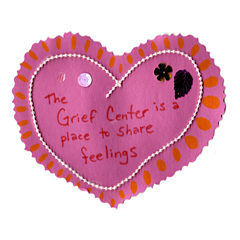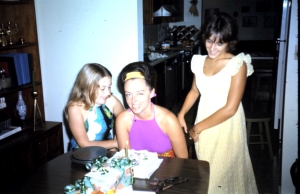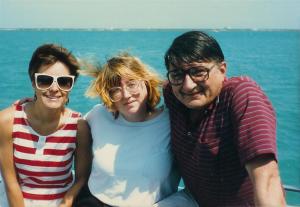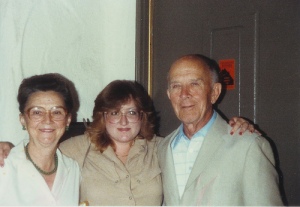Recently I signed up to be a part of the outreach team for the Children’s Grief Center (CGC) and while I know it’s important to share information about the grief center and the services they provide to grieving families, I feel a little weird, macabre maybe because I get a little excited when I hear about someone who is grieving. But really it’s because I know just the place for them! I know the CGC can help!
This past week I had my first opportunity to share my grief story with the Kiwanis, and so I thought I’d share it with you here:
My name is Jennifer and my mother died when I was 13.
First there was shock which slows everything down to a pace that allows your mind to catch up with the loss. Shock after the death of a loved one gets you through the phone calls, able to say, “I just wanted to let you know that Donna died,” or nod in agreement, “Yes, she is no longer in pain.”
Shock lets you choose a casket, select music for the funeral, write the eulogy, arrange food for after the funeral.
Only then do you realize that everything has changed.
My family stopped having family dinners, and picnics, and parties. We stopped going to church. My mother had been the lynch pin that held us together.
I quit horseback riding and dance classes and by the time I entered high school I was hanging out in the school back parking lot to smoke pot, and spending Friday and Saturday nights cruising Maple Avenue, drinking rum and cokes.
My 19-year-old sister Debby moved to Chicago.
I became The Girl Whose Mother Died, a label that I clung to for too many years. I let it define me.
My father coped by working long hours, dating, and drinking– falling “asleep” on the sofa. In the morning he’d ask, “What time did you get in last night?”
“Before you,” I’d say, laughing.
It’s funny, they say there is no WRONG way to grieve, but I’m pretty sure that the way we handled grief was not healthy. We could have used some help, but my Dad was a Captain in the Navy and one grandfather was a retired Admiral, the other Commander of the Whidbey Island Naval Air Station BY GOD and my great grandfather was an Old Salt who lied about his age and joined up when he was 13. Rightly or wrongly my dad feared any kind of “therapy” would damage his career.
So we muddled through the best we could and pretended everything was fine. “Soldiered on” I guess you’d say. We didn’t talk about the grief, or my mother.
For a long time my grief was a heavy blanket that I dragged around, a fog that kept me from remembering the times before cancer and death and kept me from imagining my future. Once a straight A student, I didn’t take the SATs and didn’t apply to any colleges and ended up instead at the local community college, dropping out before the first semester ended.
Thankfully a year after I graduated high school I figured out that pot and booze and a minimum wage job at Chuck E. Cheese’s Pizza Time Theater was NOT the life I’d dreamed of so I moved from my father’s house in northern Virginia to California where I lived with my grandparents and started college for real. In many ways I got my act together… but I still hadn’t really finished grieving.
My grief became an overabundance of black sweaters, black headbands, black shoes, my black leather coat. If anyone asked I’d say, “My mother’s death made me stronger.” As if speaking the words aloud would make it true. I didn’t learn to tell stories of my mother until much later, after I started writing a book about her, and after I became a bereavement group facilitator at the Children’s Grief Center four years ago.
One of the most important things we do at the Grief Center is create a place for kids (and their parents) where they know they are not alone. We create a place where they don’t have to carry a label like The Girl Whose Mother Died. Instead, they learn to talk about their loved one, they can cry, and they can laugh again, too. We create a safe place for families not to get OVER grief, but get through it, learn to live with it.
 The Children’s Grief Center is where I learned the true power of remembering and sharing our stories. It is in constructing our stories that we reconstruct ourselves.
The Children’s Grief Center is where I learned the true power of remembering and sharing our stories. It is in constructing our stories that we reconstruct ourselves.
I’d like to think that had there been a Children’s Grief Center in suburban D.C. in 1978 my dad would have taken me there. Maybe we would have gotten the help that we needed. Maybe we would have learned to talk about our loss, and maybe we would have shared our stories, our feelings. Maybe we would have handled our grief differently, better.
I volunteer at the Children’s Grief Center now because I believe I’m helping create what I needed 30 years ago, what every child who has experienced a significant loss deserves.
The Children’s Grief Center serves young people ages 5 to 25 who’ve experienced the death of a parent (or primary caregiver) or sibling. We also offer optional groups for their caregivers. At no charge.
Groups meet every other week during the school year at our North Valley headquarters, or at our Rio Rancho location, and dinner is included! We couldn’t do this work without support from people like you.
There are lots of ways you can help and you don’t have to have suffered a significant loss to make a contribution, you just have to have an open heart:
• If you know a young person who has lost a loved one, make sure the family knows about our services.
• Get on our volunteer list and help by serving meals, or putting in time on special projects like raking leaves or pulling up goatheads…
• You can become a bereavement group facilitator …. our next training is in August.
• The Children’s Grief Center also hosts a summer camp in July open to kids throughout the state of New Mexico who are grieving. And there are plenty of volunteer opportunities there.
• In February you can attend our Healing Hearts fundraiser luncheon—and buy something from our silent auction (we get some amazing things donated)
• And of course, you can straight up write us a check
Sometimes I feel guilty about my service at the Children’s Grief Center—it’s the most rewarding volunteer job I’ve ever had and I continue to learn about grief, and enrich my understanding of how my mother’s death affected me and my family.
Now my grief is an altar in my entryway, a poem, a memoir-in-progress, a heart tattooed on my arm. Grief is something I carry with me, a small rock in my pocket, fingered smooth. Sometimes I take it out and show people. Look at my grief, I say.
Visit the website at http://www.childrensgrief.org to learn more.
I’m working on memorizing this so I can more easily ad lib depending on the crowd and my co-presenter, but for my first time out it went pretty well I think.




